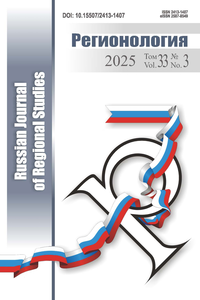S. Ya. Suschiy. Northern Black – Azov Sea Region: Demographic and Economic Potential and Prospects of Economic Development of New Regions of Russia
doi: 10.15507/2413-1407.127.032.202402.345-367
UDК 314.04:314.143
Abstract
Introduction. The interstate transit of the Northern Black Sea ‒ Azov region, which took place under the conditions of the armed conflict, was associated with a large-scale geodemographic and socio-economic transformation of regional societies. The aim of the study is to investigate the available demographic resources and production potential of the Cherson and Zaporozhye Regions, to determine the most likely directions of their economic dynamics.
Materials and Methods. The analytical and empirical base of the study, in addition to scientific sources, included collections of statistics, as well as media publications documenting the demographic and economic dynamics of the studied regions in 2022–2023. The methodological basis was a systematic approach that allowed combining the methods used in demography, social and economic geography with elements of structural-functional approach and discourse analysis of information obtained from media publications.
Results. It was found that during the spring and summer of 2022, there was a significant decrease in the available population of both areas as a result of outmigration. Moreover, the losses of the urban population were higher than those of the rural population. The maximum population losses were suffered by the Dnieper cities and the settlement network of the frontline zone of the Zaporozhye Region. In both areas, the age structure of the population has significantly deformed (a significant increase in the proportion of elderly and old people), the shortage of specialists in the main areas of socio-economic activity has sharply worsened. It is recorded that in 2022–2023 the only major sphere of economic life that continued to function on a scale comparable to peacetime was agricultural production and related segments of industry (primarily food).
Discussion and Conclusion. Demographic and socio-economic prospects for the development of both regions will largely be determined by the further dynamics of the armed conflict. The prolongation of its active stage will accelerate the process of reducing the local population due to outflow, and in the economic sphere will contribute to the deepening of agricultural (and more broadly – Agro-industrial) specialization of regional economic complexes. A stable truce will allow to diversify the directions of economic growth, first of all, to activate a number of industrial clusters, the tourist and recreational complex, the sphere of transport and logistics. The results of the study can be used in the development and detailing of plans for the socio-economic development of new territories.
Keywords: Northern Black – Azov Sea region, economic potential, population, migration, agro-industrial complex, recreation sector, construction sector
Conflict of interest. The author declares no conflict of interest.
Funding. The publication was prepared as part of the implementation of the State Assignment of the Southern Scientific Centre of the Russian Academy of Sciences, No. of registration of the project 122020100349-6.
For citation: Suschiy S.Ya. Northern Black – Azov Sea Region: Demographic and Economic Potential and Prospects of Economic Development of New Regions of Russia. Russian Journal of Regional Studies. 2024;32(2):345–367. https://doi.org/10.15507/2413-1407.127.032.202402.345-367
REFERENCES
1. Blokhin K.V. Russia and the West. Military-Political Conflict in 2022. Changing the Rules of the Game. Svobodnaya mysl. 2022;(2):24‒33 (In Russ., abstract in Eng.) Available at: http://svom.info/entry/1197-rossiya-i-zapad-voenno-politicheskij-konflikt-2022/ (accessed 12.10.2023).
2. Druzhinin A.G. The New Subjects of the Russian Federation: Specifics, Trends, Development Potential. Scientific Thought of Caucasus. 2022;(4):62–74. (In Russ., abstract in Eng.) Available at: http://nmkav.ru/ru/archive/2022/4/novye-sub-ekty-rossijskoj-federatsii-spetsifika-trendy-potentsial-razvitiya (accessed 12.10.2023).
3. Orlov S.L., Stroev P.V. About Some Features of Entering the National Space of Russia and About the Economic Potential of New Territorial Formations. The Review of Economy, Law and Sociology. 2022;(4):39–43. (In Russ., abstract in Eng.) Available at: https://www.vestnykeps.ru/0422/7.pdf (accessed 12.10.2023).
4. Belik E.V. [Development of Resort Areas of Seaside Territories of the Zaporozhye Region, as a Variant of Optimization of the Territorial Structure of the Region]. Uchenye zapiski Tavricheskogo natsionalnogo universiteta. Ser.: Geografiya. 2011;24(2-2):296–299. (In Russ.) EDN: UNXJUJ
5. Vasilevskaya Ya.V. Tourist and Recreational Resources of Kherson Region: Socio-Geographical Features. Human Geography Journal. 2013;15(2):153–156. (In Ukrainian) Available at: https://periodicals.karazin.ua/socecongeo/article/view/6497 (accessed 12.10.2023).
6. Vasilevskaya Ya.V. Nature Preserves of the Kherson Region as an Object Recreational Nature Management. Human Geography Journal. 2012;13(2):234–239. (In Ukrainian) Available at: https://periodicals.karazin.ua/socecongeo/issue/view/477/542 (accessed 12.10.2023).
7. Molodetsky A.E., Pyshnaya A.A. Balneologic, Balneomud and Climatic Recreational Resources North-Western Black Sea Coast in Resort Function of Region. Odesa National University Herald. Geography and Geology. 2014;19(4):167–175. (In Russ., abstract in Eng.). https://doi.org/10.18524/2303-9914.2014.4(23).39360
8. Nemets L.N., Vasilevskaya Ya.V., Segida K.Yu. Protected Areas of the Kherson Region in Ukraine: Structure, Territorial Differences, Problems and Prospects. Pskov Journal of Regional Studies. 2015;(22):31–42 (In Russ., abstract in Eng.) Available at: https://prj-pgpu.narod.ru/prj-22-03.pdf (accessed 12.10.2023).
9. Olenenko A. “Our New Sea Is Our New Sorrow”: The Conflict between the Ukrainian and the Soviet in the Struggle for the Design of the Lower Dnieper’s Landscape. Ab Imperio. 2019;(1):125‒152. (In Russ., abstract in Eng.) https://doi.org/10.1353/imp.2019.0008
10. Nelipa K.G. [Analysis of the Current Demographic Situation of the Zaporozhye Region]. In: [Theoretical and Practical Problems of Modern Science]. Makhachkala; 2015. p. 96–97 (In Russ.)
11. Shevtsov A.L. Modern Condition and Problems of State Regulation of Migration Processes in Ukraine. Vestnik gosudarstvennogo i munitsipalnogo upravleniya. 2013;(3):273‒279. (In Russ., abstract in Eng.) Available at: https://cyberleninka.ru/article/n/sovremennoe-sostoyanie-i-problemy-gosudarstvennogo-regulirovaniya-migratsionnyh-protsessov-v-ukraine (accessed 12.10.2023).
12. Yavorskaya V.V. Total Dynamics of Regional Geodemographic Processes in Ukraine. Visnyk of V. N. Karazin Kharkiv National University, Series “Geology. Geography. Ecology”. 2013;39(1084):201–205. (In Ukrainian) Available at: https://periodicals.karazin.ua/geoeco/article/view/7585 (accessed 12.10.2023).
About the author:
Sergey Ya. Suschiy, Dr.Sci. (Philos.), Chief Researcher, Southern Scientific Centre of the Russian Academy of Sciences (41 Chekhov Ave., Rostov-on-Don 344006, Russian Federation), ORCID: https://orcid.org/0000-0001-5131-3988, Scopus ID: 56584550300, SS7707@mail.ru
Availability of data and materials. The datasets used and/or analyzed during the current study are available from the author on reasonable request.
The author has read and approved the final manuscript.
Submitted 28.10.2023; revised 29.02.2024; accepted 12.03.2024.

Материалы журнала "РЕГИОНОЛОГИЯ REGIONOLOGY" доступны по лицензии Creative Commons «Attribution» («Атрибуция») 4.0 Всемирная
















